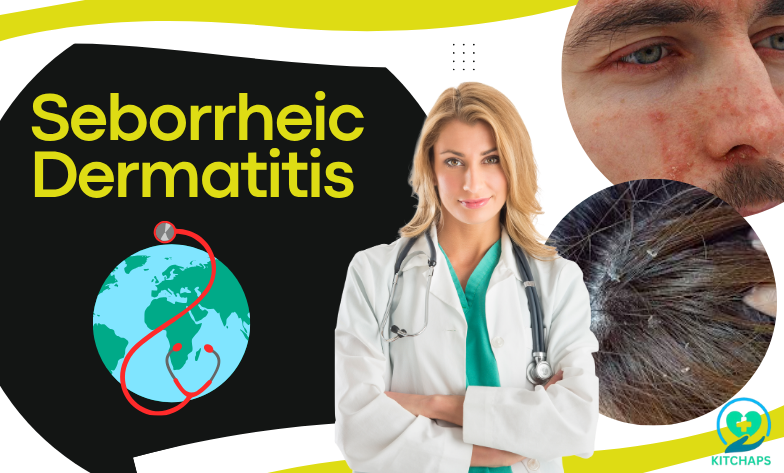Seborrheic Dermatitis affects millions of people in the world. It is an ordinary skin condition, but sometimes it is misunderstood with other disorders like psoriasis. If you have flaking, redness, and irritation on your scalp, then you are not alone. In this guide, we will break down some things to know about Seborrheic Dermatitis, misconceptions, and help you differentiate it from psoriasis. If you are seeking information about the face or scalp and treatment alternatives, then this blog is for you.
What is Seborrheic Dermatitis?
It is a long-term inflammatory skin disorder that affects the areas that are oil (sebaceous) glands. The most common affected areas include the face and scalp, but often the back and chest are also affected. In small babies, it is called “Cradle Cap,” but in adults, it is long long-term and worse health condition.
The seborrheic dermatitis is not affected by unbalanced hygiene and is not contagious. But it causes some tenderness and makes you self-conscious due to transparent signs.
What Causes Seborrheic Dermatitis?
The exact reasons are not fully recognised, but some factors include:
- Malassezia Yeast overgrowing: Naturally, fungus lives on your skin, but double rapidly in oily parts, which leads to inflammation.
- Surplus oil production: Individuals with oily skin are more affected by it.
- Genetic Tendency: Genes and family history can have a role.
- Environmental Conditions: Like stress, changes in hormones, and cold weather make the symptoms worse.
- Health Conditions: Disorders related to neurodegeneration weaken the immune system and increase the risk.
Recognizing Symptoms: More than Just Dandruff
Seborrheic Dermatitis looks different depending on your skin and the affected area:
Face: Redness, scaly spots around the nose, parts of the eyes, and on the ears. It may also look oily and shiny.
Scalp: Itching, red, greasy flakes, and in some situations, causes yellow color scales on hair and scalp.
Other Parts: On chest, back, and underarms are affected particularly in severe conditions.
Diagnosis: Seborrheic Conditions
- Physical examination by the dermatologist recognized it through appearance and the affected area.
- Through your medical history, discuss the signs that activate it and help to identify similar health conditions.
- Skin Biopsy is rarely required, but it may be conducted if there is a misunderstanding between seborrheic dermatitis and skin disorders.
Saborrheic Dermatitis and Psoriasis: Spotting the Difference
| Characteristics | Seborrheic Dermatitis | Psoriasis |
| Flake Appearance | Yellow- white, greasy and thin | Dry, thick and white-silver |
| Bottom Skin | Red and swollen | Redness, swelling and plaques |
| Areas | On chest, face and scalp | Elbows, Knees, Nails and Scalp |
| Borders | Less defined | Sharply defined |
| Itchiness | Ordinary but Mild | Sometimes intense |
| Other Signs | Dandruff and Oily skin | Joint pain and nail changes |
| Frequency | Relapsing but controllable | Chronic and sometimes determined |
Prevention and Treatment: Managing Flare- Ups
Some general tips includes use the soft and gentle cleanser and keep away from harsh scrubbing. Manage your stress because it can make your symptoms worse. Also always avoid the activations because cool, dry weather conditions and products provoke the health condition.
Scalp Treatment: Seborrheic Dermatitis
- Use Ketocanozole Shampoo: It is an antifungal medication suited for the skin and scalp. ketocanozole shampoo helps in controlling symptoms like itching, redness, and peeling, which helps in repairing the health of the scalp.
- Popular Corticosteroids: Use of low power steroids decrease the inflammation and protects the skin thinning.
- Antifungal Creams: Use in the case of stubborn, Malassezia Yeast is a primary factor.
Face Treatment: Seborrheic Dermatitis
- Popular antifungals: Creams including ingredients like ketocanozole are the most effective.
- Soft Steroids: Use meagerly and under the supervision of doctor.
- Non- steroid creams: Like Tacrolimus adviced for the sensitive facial parts.
When to see a doctor
Seek doctor’s advice if the over the counter treatments don’t help. When the rashes are spreading out and it becomes painful, it shows the symptoms of infection. And for the severe cases if you are doubtful about the diagnosis.
Conclusion
Seborrheic Dermatitis is a severe but controllable skin health condition. By understanding its feaures, treatments and causes it can help you manage the signs and symptoms and also improves the life quality. If you see any unusual symptoms immediately contact to your doctor and seek medical advice.
Disclaimer: The information provided is only for knowledge. It is not medical advice; always consult your doctor before taking medicine. Do not overlook the doctor’s medical advice because you have read it here. The author is not responsible for any consequences due to the information contained in the post.
Frequently Asked Questions (FAQs):
A. No, it does not causes hair loss but the high inflammation causes temporary hair shedding. Also the hair grows back when the condition is manageable.
A. No, it does not spread person to person.
A. Use the Ketocanozole shampoo in which the main ingredient is ketocanozole.
A. There is no strong proof has been found that diet cures the condition.

